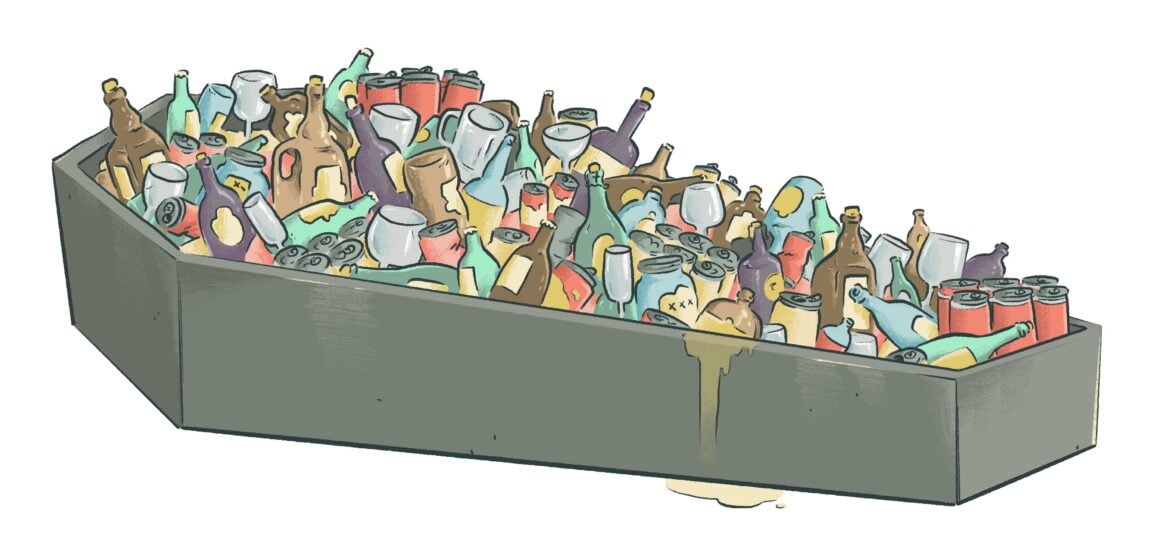More than 2,200 New Mexicans died of alcohol-related causes in 2021, according to new estimates from the Department of Health, capping a decade in which such fatalities nearly doubled and setting a new high-water mark in a state already beset by the worst drinking crisis in the nation.
The updated data arrive as lawmakers draft legislation to reduce alcohol’s harms for the upcoming session.
Laura Tomedi, an assistant professor at the University of New Mexico College of Population Health, drew on the data at a late-November hearing of the interim Legislative Health and Human Services Committee.
Tomedi, who from 2013 to 2018 led the health department’s substance abuse epidemiology section and served as its alcohol epidemiologist, told lawmakers the state’s death rate had been “going up and up and up” for years. But she described the latest trends — a 17% uptick in 2020 and another 13% jump in 2021 — as a “concerning, sharp increase.”
This spike in deaths coincided with the pandemic, she said, when “early indications are showing that alcohol use increased quite a bit.”
The mortality data, which are the most comprehensive estimates of alcohol’s full impact on New Mexicans’ health, account for all causes of death brought on by drinking including injuries in motor-vehicle crashes and violence in which the victim was intoxicated, and illnesses such as liver disease and cancer. Illness deaths due to chronic drinking made up a growing share of alcohol-attributable deaths, accounting for 62% in 2021, compared to 38% resulting from acute intoxication such as injuries and poisonings.
The data relied on updated estimates of the share of certain causes of deaths that were attributable to alcohol, which slightly raised prior years’ counts.
Deaths rose across much of New Mexico, with the biggest absolute increases in Bernalillo, McKinley, and Sandoval counties, which together accounted for more than half of the statewide increase.
Historically, the state’s response has not been proportional to the scale of the problem. Drug overdose deaths have been the focus of far greater public effort and intervention, and although they also rose quickly – by 28% in 2021 – deaths due to alcohol outnumbered them two to one, according to the health department data.
But legislators appear increasingly ready to act. This fall, several legislative committees discussed means of reducing excessive drinking and preventing related illness and injuries.
“We have to do something about it,” Sen. Antoinette Sedillo Lopez, D-Albuquerque, said in an interview. “We need to put more resources into treatment programs and prevention programs, and also raise the excise tax.”
Tomedi focused her remarks on the impact of raising alcohol taxes, which reduce excess drinking by increasing its cost. She said that conclusion was underscored by numerous scientific studies and the experience of other communities. “Higher alcohol taxes were consistently related with decreasing harm,” she said.
Currently, New Mexico levies a tax of about $0.04 per standard 12-ounce drink of beer and $0.07 per glass of wine or shot of liquor. The rates, which do not adjust with inflation, are at their lowest real value since 1993.
At the end of the hearing, the committee endorsed a proposal for the 2023 legislative session that would increase alcohol taxes by a quarter per drink and automatically adjust the rates upward to keep pace with inflation. The bill, drafted by Rep. Joanne Ferrary, D-Las Cruces, resembles legislation she introduced in 2017 that made little headway.
The updated version also eliminates the lower tax rate local microbrewers currently enjoy on their first 60,000 barrels of production.
“It seems like they have been given time to get established, which was the intent for their
exception,” she said in a text message, although she acknowledged she had not yet spoken to any breweries about it.
Ferrary intends to bring the proposal to a mid-December hearing of the Revenue Stabilization and Tax Policy Committee.
Sen. Gerald Ortiz y Pino, D-Albuquerque, said he is drafting another bill based on last session’s Senate Bill 207 that would shift some state alcohol tax revenues to county treatment and prevention programs and leverage them for federal Medicaid dollars. Currently, more than half of the funds are put in the state’s general fund and the remainder are allocated through the state’s local DWI councils.
At the committee hearing, Tomedi also raised the possibility of setting a “minimum unit price” for alcoholic beverages, which would prohibit the sale of alcohol cheaper than that threshold. In Scotland, which in 2018 established a minimum unit price of $1.07 per standard drink (£0.50 per 8 grams of pure alcohol), alcohol sales fell 3% in the three years that followed after controlling for other factors, according to a recent report by government evaluators.
Supermarkets and liquor stores in New Mexico currently sell alcohol for as little as 30 cents a drink.
